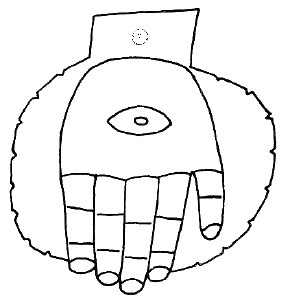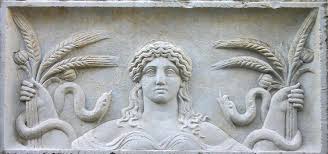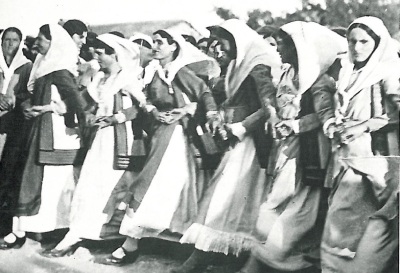The Acheulian Goddess was carved by a nomadic hominid tribe who predated even the Neanderthal era, and has been recently carbon dated as camping at Berekhat Ram (in the modern-day Golan Heights region of Israel) between 232,000 and 800,000 years ago!
The Berekhat Ram Figurine (The Acheulian Goddess) is a 35mm high fragment of volcanic rock (basaltic tuff) that was found between two layers of volcanic flow in the Levantine area of southern Syria. It is thought to be between 233,000 and 800,000 years old, dating from the Acheulian paleolithic era, and has been attributed to either Archaic Homo Sapiens or to Homo Erectus. The artisan is believed to have taken a small stone with existing feminine features, and used a flint tool to incise grooves delineating the head and arms, thus creating the oldest known human image. From scoria stone they carved the astounding figurine which, according to the Journal of the Israel Prehistoric Society,
"...might be considered the earliest manifestation of a work of art." |
 | |
It is remarkable to note the similarities between the Willendorf and the far, far older Acheulian. Both figures are distinctly female, great breasted with featureless head and discrete limbs. Using flint tools, the maker of the Acheulian intentionally adapted an existing small stone which already had breast-like Mother Goddess features "...by adding incised grooves delineating the head and arms." Like Willendorf the Acheulian appears to have a groove suggestive of the sacred vulva.
| Over a thousand miles and an amazing quarter-million years separate this piece from the famous Willendorf Goddess find in Austria. Until the past few decades, the Willendorf, carved of bone circa 32,000 years ago, was held to be the earliest human crafted work of art and veneration. |
In trying to find links to this for this article, I can't help but laugh at the "patriachal paradigm predjudice" which is that these "venus" figures are somehow extremely ancient forms of pornography. As if the image of life nurturing breasts, and vulva from which the miracle of birth ensues, could only symbolize male sexual pleasure.
It took a brilliant women archeologist, Marija Gimbutas, to look at the ubiquitious forms, previously called "fetish objects" and realize that they did not represent the Paleolithic notion of a playboy centerfold, but rather, they were sacred talismens representing the Prime Deity, the body of the Goddess from which life issues and, as in cave arts, to which life returns as well. They were probably carried for protection, fertility, and other spiritual reasons.
An example of this extraordinary inability to see the obvious, not to mention an amazing dismissal of the abilities and needs of the female side of humanity going back half a million years............may be found in the article I quote from below, describing one of the "Earliest Representations of the Female Body"*** in which a (male) archeologist notes that the form is "sexually aggressive" and must have "been carved by a man to represent his girlfriend". Amazing assumptions!***

** There is an incised pattern found on a mollusk shell that is approximately 500,000 years old, believed to have been made by pre-humans. http://news.discovery.com/human/evolution/oldest-art-was-carved-onto-shell-540000-years-ago-141203.htm *** "As one male colleague remarked, nothing has changed in 40,000 years," said Nicholas Conard, a paleoanthropologist at the University of Tubingen and the proj's leader. "It is the oldest example of figurative art in any class, making it all the more surprising that the figurine presents such a powerful, sexually aggressive image." "All place emphasis on sexual attributes and lack emphasis on the legs, arms, face and head, made all the more noticeable in this case because a carefully carved, polished ring "“ suggesting that the figurine was once suspended as a pendant "“ exists in place of a head," he added. Professor Paul Mellars, an archeologist at the University of Cambridge, wrote a commentary about the Venus to accompany the publication of the group's findings in Nature magazine. "It's at least as old the world's oldest cave art," Mellars wrote, adding that the observer "can't avoid being struck by its very sexually explicit depiction of a woman. The breasts really jump out at you." In an interview with Discovery news he added, "I assume it was a guy who carved it, perhaps representing his girlfriend "¦ Paleolithic Playboy? We just don't know how it was used at this point, but the object's size meant it fit well in someone's hand." http://www.redorbit.com/news/science/1688745/archeologists_find_oldest_representation_of_a_female_body/#ETgWQoGupLDIpRJs.99 |



























